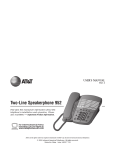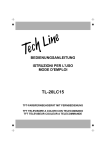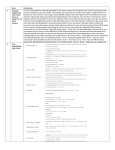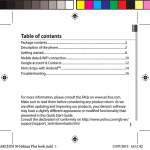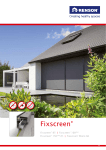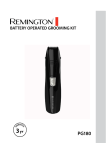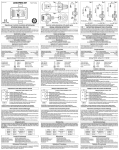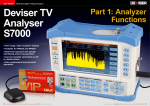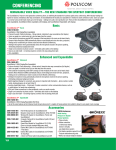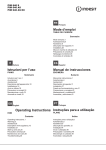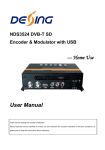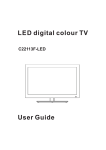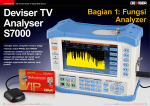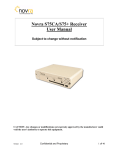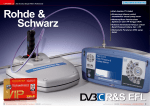Download شاشة عرض كريستال سائل للفيديو على الواحهة األمامية موالفات لبث الفيد
Transcript
جهاز استقبال و فك ترميز مدمج باحتراف تقرير اختبار ديكسينج NDS3975 •شاشة عرض كريستال سائل للفيديو على الواحهة األمامية •موالفات لبث الفيديو الرقمي عبر القمر الصناعي للجيل الثاني و البث الرقمي األرضي و عبر الكوابل وتتوفر الخدمات المتكاملة للبث الرقمي األرضي •معدد مدمج •دعم متزامن للموالف ,بروتوكول االنترنت و مدخل ASIمن جانب المدخل اضافة لبروتوكول االنترنت و مخرج ASIعلى جانب المخرج •يدعم منفذي واجه ةالنفاذ المشروط 81 www.TELE-audiovision.com — 01-02/2013 — TELE-audiovision International — 全球发行量最大的数字电视杂志 80 TELE-audiovision International — The World‘s Largest Digital TV Trade Magazine — 01-02/2013 — www.TELE-audiovision.com TEST REPORT Professional Integrated Receiver and Decoder IRD with three different inputs The NDS3975 is shipped in a rather plain-looking cardboard box, yet as soon as you open the packaging you learn that looks can be deceiving: Out comes a topnotch product that is protected by foamed material on all sides, plus all cables that are required to get going in a flash. You’ll find the power cable as well as cables for ASI, YbPbR and composite video. The IRD (integrated receiver decoder) NDS3975 is designed with the standard 19-inch rack width in mind and sports spotless build quality that seems to suggest ‘I’m made to last!’. In addition, a look at the rear panel puts us in for another surprise, as there are more connection options available than most of us would think possible: - power input - 3 x RJ-45 (IPTV input – „FE“, IPTV output – „GE“, as an option and not available on our test unit, NMS – maintenance) - 1 ASI input - 4 ASI outputs - 1 tuner input (DVB-S2/ C/T as selected, our test unit was equipped with a DVB-S2 tuner) - 1 HDMI port - 1 composite video output - 1 audio output (L+R) - 1 YbPbR component output What truly set our hearts ablaze, however, was a second look at the front panel: Apart from the two-line LCD display, which is extremely easy to reads thanks to its blue backlighting, two arrow keys and three additional buttons for Enter, Menu and Lock we discovered a small screen. Could it be true? Does this new IRD come with a small monitor right on the front that can show live TV with its 38mm diagonal? There was only one way to find out – quickly connect and set up the device! Yes, this small monitor has a surprisingly high resolution and can easily replace an exter- nal monitor for most purposes. There’s even a small switch to turn it on or off, so that it stays dark whenever it isn’t required. In addition, the front panel is characterised by six status LEDs (Power, Tuner Lock, ASI Lock, IP Lock, Decoder OK and Alarm), plus two CI slots on the right side, which turned out to be compatible with all our CAMs except those working with the CI+ standard. When we think of integrated receiver decoders (IRD), we usually have in mind professional reception devices for head-ends. Contrary to conventional consumer receivers, IRDs are designed for permanent use. This means, the ultimate benchmark is not convenience and fast zapping, but receiving a channel or transponder for any length of time up to several years and making that signal available for further processing and distribution. The major specifications for IRDs are: - high reliability - 19-inch rack format - high usability - excellent reception quality 0.61 - signal output with very good quality - low maintenance costs The NDS3975 receives high scores for each of these demands, and yet it offers so much more. It’s best to have a look at illustration 1 to get an impression of its versatility. The main difference between the NDS3975 and standard IRDs can be found right at the beginning of this report: It features three usable inputs, instead of one tuner only. While the tuner itself is exchangeable – which means you can either choose DVB-S2, DVB-C or DVB-T – there is an ASI input as well as an option to receive a transponder stream via a dedicated network interface. This means that it is possible to receive a satellite transponder through the built-in DVB-S2 tuner and at the same time feed in a second transponder from another IRD via ASI. Still looking for some icing on your cake? There you are: A third transponder can be integrated via IP at the very same time. ■ Illustration 1: Versatility of IRDs Of course the NDS3795 features a re-multiplexer which can be set up to rebundle channels of the three received transport stream into a new transport stream without any limitations whatsoever (‘muxing’). The newly multiplexed stream is then made available via the two ASI outputs as well as through the network interface for further processing. Illustration 2 gives an example of how a typical cable head-end could look like. Simultaneously, the transport stream of the tuner is available via two additional ASI outputs, and the inte- grated MPEG-2/MPEG-4 decoder can even provide the selected channel as HDMI, SDI or CVBS. This is also the channel that can be viewed on the built-in mini monitor, which means the NDS can at the same time provide analog video signals for CATV, for example. The fact that the NDS3975 does not only come with two CI slots for conditional access modules but also sports an integrated BISS decoder goes to show that the manufacturer Dexing has tried to really meet all customer demands. BISS is short for Basic Interoperable Scrambling System and was defined by the European Broadcasting Union in order to allow encryption for occasional transmissions (feeds, etc.) without having to deal with all the obligations imposed by proprietary solu- tions like PowerVu, for example, which would cause incompatibilities on too many levels. BISS is an open platform which can easily be implemented by manufacturers without any hassles. As far as broadcasting companies are concerned, BISS offers the benefit of adding encryption to sports feeds without incurring additional costs. The transmitting and the receiving end ■ Illustration 2: Example for using the NDS3975 in a network 01-02/2013 Dexing NDS3975 Most powerful and versatile IRD ever - its built-in monitor is a unique plus. www.TELE-audiovision.com/13/01/dexing 82 TELE-audiovision International — The World‘s Largest Digital TV Trade Magazine — 01-02/2013 — www.TELE-audiovision.com www.TELE-audiovision.com — 01-02/2013 — TELE-audiovision International — 全球发行量最大的数字电视杂志 83 ■ Illustration 3: Menu structure of the NDS3975 merely have to agree on a key for reliable and costefficient encryption. Dexing definitely deserves special praise for implementing this encryption method in its NDS3975 as well. To make sure we can look at all features and functions of the NDS3975 we set up a small head-end in our test center. A second IRD with ASI output was added to provide a complete transport stream from ASTRA 19.2° East, and with the help of the TSReader software (see test report in TELEaudiovision 09-10/2012) we also provided the locally available DVB-T transponder. The NDS3975 itself was set up to receive a second transponder of the ASTRA 19.2° East satellite. We then verified all results using a professional meter with ASI input, while at the same time distributing the transport stream generated by the NDS3975 to our PC using UDP Unicast. The Dektec DTS-215 Gold (see test report in TELE-audiovision 12-02/2012) was installed in our PC to re-modulate the signal into the DVB-C and DVB-T standards. Once that was achieved the final signal could easily be tested on any standard DVB-C or DVB-T receiver. When you go about setting up the NDS3975 you can follow two different routes: You may choose to do all the configuration right on the device itself (frontend operation) thanks to the LCD screen and the seven control buttons, or you can download the Network Management Software (NMS operation) from the Dexing website at www.dsdvb.com free of charge. We embarked on route 1 first, which is self-explanatory once you have grasped the meanings and functions of the Enter, Menu and Lock buttons. Lock, for instance, switches between status display and menu, so one could argue that Lock in this context means that the configuration menu cannot be 84 TELE-audiovision International — The World‘s Largest Digital TV Trade Magazine — 01-02/2013 — www.TELE-audiovision.com accessed when status display is active. Once the configuration menu is called up you can use the Up/Down buttons to navigate between different menus. The menu option that is shown in the first line can be activated with the Enter button, and the Menu button brings you up one menu level. A highlighted option in a sub-menu can be activated with the Enter button and edited with the four arrow buttons. This way editing frequencies or symbol rates becomes a surprisingly straightforward affair. When you’re done editing a touch of the Menu button confirms all parameters. Illustration 3 shows the menu structure of the NDS3975. Before we went about configuring the NDS3975 we first defined which channels should be included in the final transport stream: - ARD (from the tuner of the NDS3975) - ZDF (from the ASI input) - RTP-1 (from the IP input) - RTP-2 (from the IP input) - SIC (from the IP input) - TVI (from the IP input) This channel list is based on three different transport streams, which should be fed to the NDS3975 using the following scenario: 1) Tuner: Using the built-in DVB-S2 tuner transponder 19 from ASTRA 19.2° East (11494 H 22000-2/3 8PSK) is received. This transponder carries the German public broadcaster ‘Das Erste’ in high definition, among other channels. 2) ASI: Using the ASI input transponder 77 from ASTRA 19.2° East (11954 H 275003/4 QPSK) is fed to the IRD. It is entirely on purpose that we set up the second transport stream with a standard definition transponder, so that we could check out how capable the multiplexer of the NDS3975 is. 3) IP: The IP input should receive its signal from a PC with TSReader Pro. To that end, we installed a BDA compatible DVB-T USB receiver 1 2 3 5 4 1. Everything is hunky-dory, with the LCD screen showing the current data rate. 2. What a fascinating feature: The built in mini-screen can present the currently selected channel with high resolution. This way you won’t need an external monitor. Pure genius! 3. The small screen has exactly the same content as our external monitor, which we connected via DVI and a corresponding adapter. The NDS3975 even delivers audio in addition to video. 4. The transport stream generated by the NDS3975 was passed through to our meter that has an ASI input. 5. Almost like a professional studio: The NDS3975 (left, under the monitor), IRD, DVB-C receiver, DVB-T receiver, PC with TSReader and Dectek DTU-215 Gold installed. 86 TELE-audiovision International — The World‘s Largest Digital TV Trade Magazine — 01-02/2013 — www.TELE-audiovision.com on our PC and streamed the entire 754 MHz transponder of the local DVB-T in Portugal to the NDS3975 via UDP. This stream is comprised of five channels with MPEG-4 and AAC compression. These three transport streams should be muxed into a newly created transport stream carrying the channels listed above. In addition, the new stream should be given out both via ASI and IP. The IP stream will be forwarded to a Dektec DTU-215 Gold, which will take care of modulating the IP stream into a DVB-C signal which will then be led to our improvised cable headend. These are the steps we took to set up the NDS3975 for our test scenario: 1) Configuration of the built-in tuner: To start with, we had to change the tuner’s LOF to 9750, since by default it is set up for the C band. Next, we entered the frequency (11494 MHz), symbol rate (22000) and LNB voltage (18V for horizontal). Once the Tuner Lock status LED indicated a locked signal we went to the Prog Parse sub-menu and started a channel search. 2) Configuration of the ASI input: All we had to do is initiate a search in the Prog Parse sub-menu. 3) Configuration of the IP input: By default, the NDS3975 comes with some useful parameters for IP interfaces, which meant we did not change the multicast address 224.2.2 at port 1001. Once again, we then proceeded with the search in the Prog Parse sub-menu. 4) We then had to turn to the output side. The NDS3975 can be set to pass through the transport stream from one of the inputs (tuner, ASI or IP) directly to the IP output, or to lead all input signals to the re-multiplexer first. We opted for the latter, since our end result should be a single transport stream with six channels. We also configured the output bitrate. We did not edit the network IDs at this stage, even though the NDS3975 gives users that possibility too. What we did change, however, was the IP address for the IP stream output. By default, a multicast IP address was entered here as well, but we thought it would be wise to stream directly to one of our test PCs via Unicast. This way www.TELE-audiovision.com — 01-02/2013 — TELE-audiovision International — 全球发行量最大的数字电视杂志 87 4 1 2 could then be received and processed with any standard DVB-C receiver. Even all additional features and services such as teletext were available without a glitch. The conclusion we drew from building our own lit- happy about that, since it is labelled Alarm. In step 4 just above we had activated Multiplex, which meant we needed to define which channels from the three inputs should be taken over. As mentioned in the beginning, the NDS3975 can also be set up with great ease using the Network Management Software (NMS) right on the PC. For the Multiplex setup we opted for that very convenient option. The software is not designed specifically for the NDS3975 but works with all Dexing products. This way a head-end equipped with different Dexing products can be set up and controlled with a single software solution. The tree structure of the software allows defining 5 6 3 4. Channels received by the tuner can be descrambled with one of the two plugged in CAMs. It’s interesting to note that each channel can be individually paired with one of the two CAMs. 5. The ‘Mux’ tab takes care of re-multiplexer configuration, which could not be easier: on the left side you select a source channel and by clicking on the arrow button pointing to the right it is added to the target stream. Selecting a channel on the right side and using the arrow button pointing to the left, the channel is removed from the target stream. 6. The NDS3975 is a professional device, which is why it comes with a fully implemented BISS decoder inside. Simply enter the current BISS key, select the BISS version and you’re done. 1. All Dexing devices are supported by the NetworkManagement Software, allowing entire head-end stations to be managed with a single software solution. 2. The “General Parameters” tab shows all main configurations and here the video signal can be adjusted as required. 3. To be seen on the left: Tree structure with TELEaudiovision group and Dexing NDS3975. To the right: Parameters Tab showing Tuner Parameters of the integrated tuner. Our IRD is equipped with a DVB-S2 tuner. we could eliminate potential network problems in our test center. 5) In the Decoder Settings menu you can freely select the video and audio formats, with a huge array of options available. We restricted ourselves to perform a tuner search and then selected ARD HD. This meant that ARD HD would be available from the video and audio outputs of the NDS3975 as composite video, component video and HDMI. In addition, this was also the channel that would be displayed on the mini screen on the front panel. Any channel can be selected for output, no matter whether it’s in the transport stream of the tuner or comes for the ASI or IP inputs. 6) We did not change the network configura- tion, since the pre-defined IP address of the NDS3975 (192.168.1.210) worked brilliantly for our test network. As soon as a single change of the NDS3975 parameters is confirmed the IRD becomes active. You can see this with all five LEDs lighting up: Power, Tuner Lock, ASI Lock, IP Lock and Decoder OK. Only one LED remained dark, and we were quite 88 TELE-audiovision International — The World‘s Largest Digital TV Trade Magazine — 01-02/2013 — www.TELE-audiovision.com groups which can be used to control several head-ends at the same time, for example. Each group can then be set up to manage any number of Dexing devices. The one thing you need to make sure is to select the correct device from the drop-down list, so that the corresponding tabs show the menu options for that particular device. After entering the IP ad- dress of the NDS3975 (IP 192.168.1.210 in our case) and confirming it all parameters of the receiver can be accessed, read and changed as required. This is way faster and much more efficient than making all adjustments directly on the box. Each device is shown in the tree structure with a virtual LED in front of its name. This LED lights up in green whenever a connection between software and receiver is established, and if no connection is possible this is indicated with a red light. We believe this is an extremely user-friendly solution and for large installations, in particular, you can identify potential problems at a single glance. On the left side of the MUX tab all received channels are listed according to input, while the software lists channels that should be packaged into the output stream on the right side. This way it does not take rocket science to set up a new Mux. In fact, you don’t even have to consult a manual. Once the final settings have been transferred to the NDS3975 our meter with ASI input detected the incoming transport stream. What’s more, all channels of the stream could be received nice and clear. Next, we turned to the Dectek DTU-215 Gold. First, we set up the MuxXpert software – which is available as an option – to make sure the IP stream from the NDS3975 is handed over directly to the DTU-215, which in turn would take care of modulating the stream into a DVB-C signal. At this point you should take care of the input bandwidth, which must not exceed the maximum bandwidth for the selected modulation. At the beginning we simply could not resist the temptation of adding too many channels to a single transponder, but after we had reduced that number to six everything was alright and worked flawlessly. The frequency that was created with MuxXpert (447MHz, 64QAM, SR 6875) tle head-end station was that this was not only an interesting and worthwhile undertaking, but can also easily provide residential accommodation, hotels or hospitals with complete TV bouquets via DVB-C/T or IPTV. As always, we put the integrated tuner itself to a thorough test as well. The results show that it is able to lock a signal even if the antenna is on the small side and delivers a rather sketchy input signal. What’s more, we also tried to provoke errors feeding the IP input with a faulty transport stream – but to no avail! Turning the transport stream via ASI and IP off and on again did not bother the NDS3975 either, it performed brilliantly whenever a stream was fed to one of its inputs. All that happens when the ASI cable is disconnected, or the feeding receiver is switched off, for example, is that the status LED ceas- www.TELE-audiovision.com — 01-02/2013 — TELE-audiovision International — 全球发行量最大的数字电视杂志 89 es to light up. No troubles caused, no tricks required – that’s what we like about this IRD. There’s one more thing that deserves special praise: Whenever video cannot be put out due to faulty reception, for instance, there is only a short alert message indicating the signal failure. After that, the screen simply remains dark. We believe this is a very smart solution, since end users do not need to know the precise cause of a problem. After all, would you want “Bad reception – please tune your dish” to pop up on the TV sets of your cable TV customers? A blank screen is much less embarrassing, don’t you think? So does all this mean we could not even find the slightest fault with this product? Well, the receiver we were sent for testing came without a user manual. But then again, we found out right away how to use the IRD and hardly ever noticed that the manual was missing. This in itself speaks volumes about the user concept of the NDS3975, which is self-explanatory like only few other products we had tested before. And in case you didn’t know: The iPhone doesn’t come with a manual either. We had a total of three weeks to check out every nook and cranny of the NDS3975 while it was running without interruption. Were we faced with any technical problems or malfunctions? Far from it! This is all the more impressive, since our tests place the highest of demands on all devices and we usually don’t give up until we detect a flaw. The NDS3975 got the better of us, which means we can only congratulate Dexing on a top-quality product. The IRD NDS3975 is top-notch product in a league of its own. Not only is it a professional receiver, but an integrated device combining tuner, ASI and IP into an excellent package complete with re-multiplexer. Add to that a highperformance demodulator capable of giving out video as HDMI, component video or composite video and you end up with a state-of-theart offering. With the option of re-multiplexing the transport streams right within the system it can do away with or at least reduce the number of required standalone multiplexers, depending on the field of application. Thanks to its wide range of features and functions the NDS3975 is fit for the future as it can always be adapted to new or enhanced requirements. When they go out to buy a professional receiver 90 TELE-audiovision International — The World‘s Largest Digital TV Trade Magazine — 01-02/2013 — www.TELE-audiovision.com these days many people are worried their purchase may turn into a waste of money as soon as some framework conditions change. Owners of the MNDS3975 need not have such worries, since all their product will require is an updated configuration to stay ahead of the pack. Conventional tuners, on the other hand, more often than not must be replaced by a new model. In our final verdict we can whole-heartedly recommend the IRD NDS3975 without any restrictions. Never before has a similarly robust, versatile and fascinating professional receiver made its way to one of our test centers. The icing on the cake is provided by the mini screen on the front panel, which had us wonder why something useful like this has not been available before. 1 2 9 10 12 Expert Opinion 13 + Very robust and sensitive Tuner Multiple reception (Tuner, ASI and IP) Integrated Re-Multiplexer Many output options (ASI, IP, HDMI, Component, Composite) Simultaneous tuner pass-through to ASI – None Vitor Martins Augusto TELE-audiovision Test Center Portugal TECHNICAL 3 11 DATA 14 Manufacturer Dexin Digital Technology Co. Ltd. [email protected] Websitewww.dsdvb.com/english ModelNDS3975 Function 4 5 6 7 8 1. Main menu: All menu items are numbered, which greatly facilitates all documentation and remote support. Based on the menu number it is easy to communicate which parameter has to be adjusted and in what way. 2. We started out by accessing the Input menu and from there going to Tuner Configuration. 3. The correct frequency has to be entered in menu item 1.1.2 for a satellite transponder to be received properly. 4. Don’t forget to make sure the right LOF is given in menu item 1.1.3. 5. Now the symbol rate has to be entered in item 1.1.4. 6. This is followed by menu item 1.1.5, which takes care of the correct polarisation – V or H. 7. The only thing that’s still missing is the high or low band, i.e. 0/22 KHz. You can set this in menu item 1.1.6. 8. Time for a signal scan (menu item 1.1.1 – Prog Parse), which delivers all channels of the transponder. Each channel can be selected individually. 9. Menu items 1.2 and 1.3 must be accessed to set up the ASI and IP input. 10. German channel ZDF was selected in this case. This channel was fed through the ASI input. 11. As far as the IP input is concerned, the correct IP address has to be entered in sub-menu 1.3.2 first. In addition, the port has to be entered as well (1.3.3). 12. Right after that, all channels of the IP stream can be listed and selected in menu item 1.3.1. 13. Numerous adjustment options for video and audio output are available in the decoder menu. 14. In menu item 3.1.1, for example, the output resolution can be set as required. 15. Once the desired input is selected in menu 3.5 and a channel search has been performed in menu 3.4 it is possible to select the desired channel in menu 3.3. This channel is then available via HDMI, component video out and composite video out. For monitoring purposes this channel can also be watched on the built-in miniscreen. 92 TELE-audiovision International — The World‘s Largest Digital TV Trade Magazine — 01-02/2013 — www.TELE-audiovision.com Professional Integrated Receiver Decorder Input 15 Tuner Input x1QPSK,QPSK ( / / ASI Input x1 Maximum transmitting rate 90Mbps IP x1 Maximum transmitting rate 80Mbps optional) Output ENERGY DIAGRAM Apparent Power Active Power Video Output SDI: 1080i@25 ,29.94fps,720p @ 50 59.94fps, 576i@25 [email protected] fps YPbPr:1080i@ 25 ,29.94fps,720p @ 50 59.94fps CVBS: 576i@25 fps, [email protected] fps Audio Output Stereo unbalanced audio BNC interface Stereo balanced audio XLR interface Digital audio digital audio ASI Output 1#x2 One pair ASI Output 2#x2 One pair, optional IP Output x1 FE Port: MPTS&10 SPTS, maximum transmitting rate 90Mbps CAM Mode Apparent Active Active, no built-in monitort 45 W 28 W Active, with built-in monitort 46 W 28.5 W Factor 0.62 0.61 In the first ten minutes the NDS3975 was operated with three input signals and active re-multiplexing. During the last five minutes a slightly increased power consumption can be observed, which is caused by the switched on mini-screen of the front panel. Descrambling procession Supporting European DVB-CSA Smart Card interface: ISO7816 Interface Card separation: PCMCIA Graphical LCD Status and configuration Video Monitor Live TV Buttons 7x Control buttons Power Supply AC 110V-240V Temperature Range 0-450C (Operation) Dimensions 482mm×360mm×44mm 3.2Kg www.TELE-audiovision.com — 01-02/2013 — TELE-audiovision International — 全球发行量最大的数字电视杂志 93







